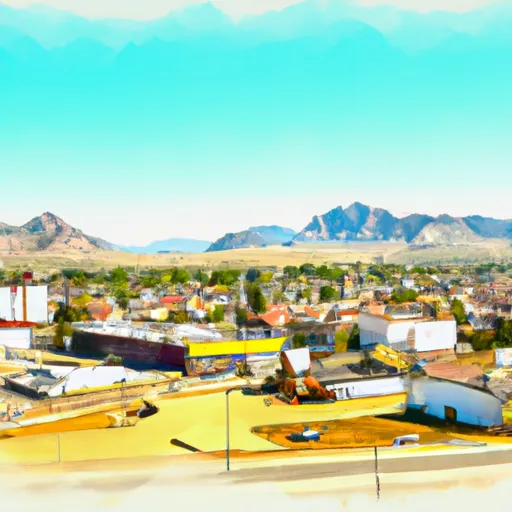-
 Snoflo Premium
Snoflo Premium
Get unlimited access to all our content
With no Ad interruptions! - Start Your Free Trial Login with existing account
Logandale
Eden Index
Climate
8.6
•
Recreation
2.8
•
Community
2.2
•
Safeguard
5.0/10

Logandale, Nevada is a small unincorporated community located in the Moapa Valley, approximately 50 miles northeast of Las Vegas. The climate in Logandale is characterized by hot summers and mild winters. Summers are long and dry, with average temperatures exceeding 100°F, while winters are cooler with average temperatures ranging from 40-60°F. The area receives minimal rainfall throughout the year, making water conservation an important consideration.
Hydrologically, Logandale is situated near the Muddy River, which provides a vital water source for agricultural purposes in the region. The river also supports diverse wildlife, including fish and bird species.
Logandale offers several outdoor recreation opportunities for nature enthusiasts. The Valley of Fire State Park is just a short drive away, known for its stunning red sandstone formations and hiking trails. Visitors can explore unique geological features, ancient petroglyphs, and enjoy camping facilities. The nearby Lake Mead National Recreation Area offers opportunities for boating, fishing, and water sports. With its proximity to the picturesque Moapa Valley, Logandale provides a scenic backdrop for outdoor activities like hiking, biking, and horseback riding.
What is the Eden Index?
The Snoflo Eden Index serves as a comprehensive rating system for regions, evaluating their desirability through a holistic assessment of climate health, outdoor recreation opportunities, and natural disaster risk, acknowledging the profound impact of these factors on livability and well-being.
Climate Health Indicator (CHI): 8.6
Logandale receives approximately
138mm of rain per year,
with humidity levels near 64%
and air temperatures averaging around
20°C.
Logandale has a plant hardyness factor of
9, meaning
plants and agriculture in this region tend to thrive here all year round.
By considering the ideal temperature range, reliable water supplies, clean air, and stable seasonal rain or snowpacks, the Climate Health Indicator (CHI) underscores the significance of a healthy climate as the foundation for quality living.
A healthy climate is paramount for ensuring a high quality of life and livability in a region, fostering both physical well-being and environmental harmony. This can be characterized by ideal temperatures, reliable access to water supplies, clean air, and consistent seasonal rain or snowpacks.
Weather Forecast
Streamflow Conditions
Lower Colorado-Lake Mead
Area Rivers
Lower Colorado-Lake Mead
Snowpack Depths
Lower Colorado-Lake Mead
Reservoir Storage Capacity
Lower Colorado-Lake Mead
Groundwater Levels
Recreational Opportunity Index (ROI): 2.8
The Recreational Opportunity Index (ROI) recognizes the value of outdoor recreational options, such as parks, hiking trails, camping sites, and fishing spots, while acknowledging that climate plays a pivotal role in ensuring the comfort and consistency of these experiences.
Access to outdoor recreational opportunities, encompassing activities such as parks, hiking, camping, and fishing, is crucial for overall well-being, and the climate plays a pivotal role in enabling and enhancing these experiences, ensuring that individuals can engage in nature-based activities comfortably and consistently.
Camping Areas
| Campground | Campsites | Reservations | Toilets | Showers | Elevation |
|---|---|---|---|---|---|
| Stewards Point Dispersed - Lake Mead NRA | None | 1,217 ft | |||
| Echo Bay - Lake Mead National Rec Area | 166 | 1,316 ft | |||
| Valley of Fire State Park | 73 | 2,005 ft | |||
| Overton WMA Dispersed | None | 1,243 ft |
Nearby Ski Areas
Catastrophe Safeguard Index (CSI):
The Catastrophe Safeguard Index (CSI) recognizes that natural disaster risk, encompassing floods, fires, hurricanes, and tornadoes, can drastically affect safety and the overall appeal of an area.
The level of natural disaster risk in a region significantly affects safety and the overall livability, with climate change amplifying these risks by potentially increasing the frequency and intensity of events like floods, fires, hurricanes, and tornadoes, thereby posing substantial challenges to community resilience and well-being.
Community Resilience Indicator (CRI): 2.2
The Community Resilience Indicator (CRI) recognizes that education, healthcare, and socioeconomics are crucial to the well-being of a region. The CRI acknowledges the profound impact of these elements on residents' overall quality of life. By evaluating educational resources, healthcare accessibility, and economic inclusivity, the index captures the essential aspects that contribute to a thriving community, fostering resident satisfaction, equity, and social cohesion.

